Evaluation of Deformation Temperatures in Carbonate Mylonites at Low Temperature Thrust-Tectonic Settings via Micro-Raman Spectroscopy
Abstract
1. Introduction
2. Materials and Methods
2.1. Rock Sample Description and Geological Constraints
2.2. Micro-Raman Spectroscopy
2.3. Spectral Treatment
3. Results
3.1. Microstructural Analysis and Related Temperature Estimates
3.1.1. STE1 Sample: Austroalpine Domain
3.1.2. EP1, EP4, and EP7 Samples: Southern Alps Domain
3.2. Micro-Raman Spectroscopy on Carbonaceous Materials
4. Discussion
4.1. Spectral Morphologies and Deconvolution
4.2. Geothermometry
- The equation proposed by Beyssac et al. [1], where the R2 parameter (R2 = D1/(G + D1 + D2) band areas) is considered;
- The parameters proposed by Sparkes et al. [10] (the RA2 parameter, where RA2 = (D1 + D4)/(G + D2 + D3 peak areas);
- The approach described in Kouketsu et al. [5], where T (°C) = −6.78 × (FWHM − D2) + 535 (for 200 °C < T < 400 °C);
- The other approach proposed by Kouketsu et al. [5], where T (°C) = −2.15 × (FWHM − D1) + 478 (for 150 °C < T < 200 °C).
4.2.1. STE1 Sample
4.2.2. EP Samples
4.2.3. Comparison of RSCM Temperatures with Microstructural Analyses
4.2.4. Procedure
- It has been demonstrated that reliable temperatures were obtained from the spectra recorded using the two sources of 532 and 632.8 nm;
- It must be highlighted that it is necessary to understand the best acquisition conditions (i.e., laser power, recording time, and instrumental settings) to obtain data not affected by sample modifications or spectra not suitable for band fitting, giving incorrect parameters and, as a consequence, T estimations;
- Baseline mode selection (e.g., linear and polynomial) is another step that can easily affect fitted band parameters, such as the FWHM, when the spectra display high fluorescence effects. All the spectra of this work were corrected through a linear baseline in the spectral range of 1000–1750 cm−1, in order to avoid, as much as possible, the subjectivity in this step of the elaboration [5,17].
5. Conclusions
Author Contributions
Funding
Acknowledgments
Conflicts of Interest
References
- Beyssac, O.; Goffé, B.; Chopin, C.; Rouzaud, J.N. Raman spectra of carbonaceous material in metasediments: A new geothermometer. J. Metamorph. Geol. 2002, 20, 859–871. [Google Scholar] [CrossRef]
- Croce, A.; Arrais, A.; Rinaudo, C. Raman Micro-Spectroscopy Identifies Carbonaceous Particles Lying on the Surface of Crocidolite, Amosite, and Chrysotile Fibers. Minerals 2018, 8, 249. [Google Scholar] [CrossRef]
- Henry, D.G.; Jarvis, I.; Gillmore, G.; Stephenson, M.; Emmings, J.F. Assessing low-maturity organic matter in shales using Raman spectroscopy: Effects of sample preparation and operating procedure. Int. J. Coal Geol. 2018, 191, 135–151. [Google Scholar] [CrossRef]
- Jehlička, J.; Beny, C. First and second order Raman spectra of natural highly carbonified organic compounds from metamorphic rocks. J. Mol. Struct. 1999, 480, 541–545. [Google Scholar] [CrossRef]
- Kouketsu, Y.; Mizukami, T.; Mori, H.; Endo, S.; Aoya, M.; Hara, H.; Nakamura, D.; Wallis, S. A new approach to develop the Raman carbonaceous material geothermometer for low-grade metamorphism using peak width. Isl. Arc 2014, 23, 33–50. [Google Scholar] [CrossRef]
- Marshall, C.P.; Love, G.D.; Snape, C.E.; Hill, A.C.; Allwood, A.C.; Walter, M.R.; Van Kranendonk, M.J.; Bowden, S.A.; Sylva, S.P.; Summons, R.E. Structural characterization of kerogen in 3.4Ga Archaean cherts from the Pilbara Craton, Western Australia. Precambrian Res. 2007, 155, 1–23. [Google Scholar] [CrossRef]
- Mirasol-Robert, A.; Grotheer, H.; Bourdet, J.; Suvorova, A.; Grice, K.; McCuaig, T.C.; Greenwood, P.F. Evidence and origin of different types of sedimentary organic matter from a Paleoproterozoic orogenic Au deposit. Precambrian Res. 2017, 299, 319–338. [Google Scholar] [CrossRef]
- Rinaudo, C.; Croce, A. Micro-Raman Spectroscopy, a Powerful Technique Allowing Sure Identification and Complete Characterization of Asbestiform Minerals. Appl. Sci. 2019, 9, 3092. [Google Scholar] [CrossRef]
- Sadezky, A.; Muckenhuber, H.; Grothe, H.; Niessner, R.; Pöschl, U. Raman microspectroscopy of soot and related carbonaceous materials: Spectral analysis and structural information. Carbon 2005, 43, 1731–1742. [Google Scholar] [CrossRef]
- Sparkes, R.; Hovius, N.; Galy, A.; Kumar, R.V.; Liu, J.T. Automated Analysis of Carbon in Powdered Geological and Environmental Samples by Raman Spectroscopy. Appl. Spectrosc. 2013, 67, 779–788. [Google Scholar] [CrossRef]
- Tuinstra, F.; Koenig, J.L. Raman Spectrum of Graphite. J. Chem. Phys. 1970, 53, 1126–1130. [Google Scholar] [CrossRef]
- Molli, G.; Vitale Brovarone, A.; Beyssac, O.; Cinquini, I. RSCM thermometry in the Alpi Apuane (NW Tuscany, Italy): New constraints for the metamorphic and tectonic history of the inner northern Apennines. J. Struct. Geol. 2018, 113, 200–216. [Google Scholar] [CrossRef]
- Lagabrielle, Y.; Clerc, C.; Vauchez, A.; Lahfid, A.; Labaume, P.; Azambre, B.; Fourcade, S.; Dautria, J.-M. Very high geothermal gradient during mantle exhumation recorded in mylonitic marbles and carbonate breccias from a Mesozoic Pyrenean palaeomargin (Lherz area, North Pyrenean Zone, France). Comptes Rendus Geosci. 2016, 348, 290–300. [Google Scholar] [CrossRef]
- Manzotti, P.; Rubatto, D.; Darling, J.; Zucali, M.; Cenki-Tok, B.; Engi, M. From Permo-Triassic lithospheric thinning to Jurassic rifting at the Adriatic margin: Petrological and geochronological record in Valtournenche (Western Italian Alps). Lithos 2012, 146, 276–292. [Google Scholar] [CrossRef]
- Henry, D.G.; Jarvis, I.; Gillmore, G.; Stephenson, M. A rapid method for determining organic matter maturity using Raman spectroscopy: Application to Carboniferous organic-rich mudstones and coals. Int. J. Coal Geol. 2019, 203, 87–98. [Google Scholar] [CrossRef]
- Lahfid, A.; Beyssac, O.; Deville, E.; Negro, F.; Chopin, C.; Goffé, B. Evolution of the Raman spectrum of carbonaceous material in low-grade metasediments of the Glarus Alps (Switzerland). Terra Nova 2010, 22, 354–360. [Google Scholar] [CrossRef]
- Lünsdorf, N.K.; Dunkl, I.; Schmidt, B.C.; Rantitsch, G.; Eynatten, H. von Towards a Higher Comparability of Geothermometric Data obtained by Raman Spectroscopy of Carbonaceous Material. Part I: Evaluation of Biasing Factors. Geostand. Geoanalytical Res. 2014, 38, 73–94. [Google Scholar] [CrossRef]
- Rahl, J.M.; Anderson, K.M.; Brandon, M.T.; Fassoulas, C. Raman spectroscopic carbonaceous material thermometry of low-grade metamorphic rocks: Calibration and application to tectonic exhumation in Crete, Greece. Earth Planet. Sci. Lett. 2005, 240, 339–354. [Google Scholar] [CrossRef]
- Sauerer, B.; Craddock, P.R.; AlJohani, M.D.; Alsamadony, K.L.; Abdallah, W. Fast and accurate shale maturity determination by Raman spectroscopy measurement with minimal sample preparation. Int. J. Coal Geol. 2017, 173, 150–157. [Google Scholar] [CrossRef]
- Lünsdorf, N.K.; Dunkl, I.; Schmidt, B.C.; Rantitsch, G.; Eynatten, H. von Towards a Higher Comparability of Geothermometric Data Obtained by Raman Spectroscopy of Carbonaceous Material. Part 2: A Revised Geothermometer. Geostand. Geoanalytical Res. 2017, 41, 593–612. [Google Scholar] [CrossRef]
- Koeppel, V.; Guenthert, A.; Gruenenfelder, M. Patterns of U-Pb zircon and monazite ages in polymetamorphic units of the Swiss Central Alps. Schweiz. Mineral. Petrogr. Mitteilungen 1981, 61, 97–119. [Google Scholar]
- Bernoulli, D.; Heitzmann, P.; Zingg, A. Central and southern Alps in southern Switzerland: Tectonic evolution and first results of reflection seismics. Mémoires Société Géologique France 1990, 156, 289–302. [Google Scholar]
- Frisch, W.; Ménot, R.-P.; Neubauer, F.; von Raumer, J.F. Correlation and evolution of the Alpine basement. Schweiz. Mineral. Petrogr. Mitt. 1990, 70, 265–285. [Google Scholar]
- Montrasio, A.; Berra, F.; Ceriani, M.; Deichmann, N.; Gregnanin, A.; Guerra, S.; Gugliemin, M.; Jadoul, F.; Longhin, M.; Mair, V.; et al. Note illustrative della Carta Geologica d’Italia alla scala 1:50.000—Foglio 24 Bormio. In APAT- Servizio Geologico d’Italia; Land and Technology Service: Padova e Treviso, Italy, 2012; p. 152. [Google Scholar]
- Berra, F.; Cirilli, S. Preservation and thermal alteration of organic matter in the Ortles and Quattervals nappes (Upper Austroalpine, Nord-Eastern Lombardy, Italy): Preliminary results and implications for regional geology. Eclogae Geol. Helv. 1997, 90, 325–336. [Google Scholar]
- Conti, P.; Manatschal, G.; Pfister, M. Synrift sedimentation, Jurassic and Alpine tectonics in the central Ortler nappe (Eastern Alps, Italy). Eclogae Geol. Helv. 1994, 87, 63–90. [Google Scholar]
- Conti, P. La falda Austroalpina dell’Ortles e l’evoluzione tettonica delle Dolomiti dell’Engadina (Svizzera-Italia) (con 17 tavole). Mem. Descr. Carta Geol. d’It. 1997, 53, 104. [Google Scholar]
- Gaetani, M.; Sciunnach, D.; Bini, A.; Rossi, S. Note Illustrative della Carta Geologica d’Italia alla scala 1:50.000—Foglio 76 Lecco. In APAT- Servizio Geologico d’Italia; Land and Technology Service: Padova e Treviso, Italy, 2010; p. 216. [Google Scholar]
- Viganò, A.; Tumiati, S.; Recchia, S.; Martin, S.; Marelli, M.; Rigon, R. Carbonate pseudotachylytes: Evidence for seismic faulting along carbonate faults. Terra Nova 2011, 23, 187–194. [Google Scholar] [CrossRef]
- Weber, J.C.; Ferrill, D.A.; Roden-Tice, M.K. Calcite and quartz microstructural geothermometry of low-grade metasedimentary rocks, Northern Range, Trinidad. J. Struct. Geol. 2001, 23, 93–112. [Google Scholar] [CrossRef]
- Ferrill, D.A.; Morris, A.P.; Evans, M.A.; Burkhard, M.; Groshong, R.H.; Onasch, C.M. Calcite twin morphology: A low-temperature deformation geothermometer. J. Struct. Geol. 2004, 26, 1521–1529. [Google Scholar] [CrossRef]
- Burkhard, M. Calcite twins, their geometry, appearance and significance as stress-strain markers and indicators of tectonic regime: A review. J. Struct. Geol. 1993, 15, 351–368. [Google Scholar] [CrossRef]
- Rybacki, E.; Evans, B.; Janssen, C.; Wirth, R.; Dresen, G. Influence of stress, temperature, and strain on calcite twins constrained by deformation experiments. Tectonophysics 2013, 601, 20–36. [Google Scholar] [CrossRef]
- Zucali, M.; Chateigner, D.; Ouladdiaf, B. Crystallographic and Seismic Anisotropies of Calcite at Different Depths: A Study Using Quantitative Texture Analysis by Neutron Diffraction. Minerals 2020, 10, 26. [Google Scholar] [CrossRef]
- Passchier, C.; Trouw, R. Microtectonics; Springer: Berlin/Heidelberg, Germany, 2005. [Google Scholar] [CrossRef]
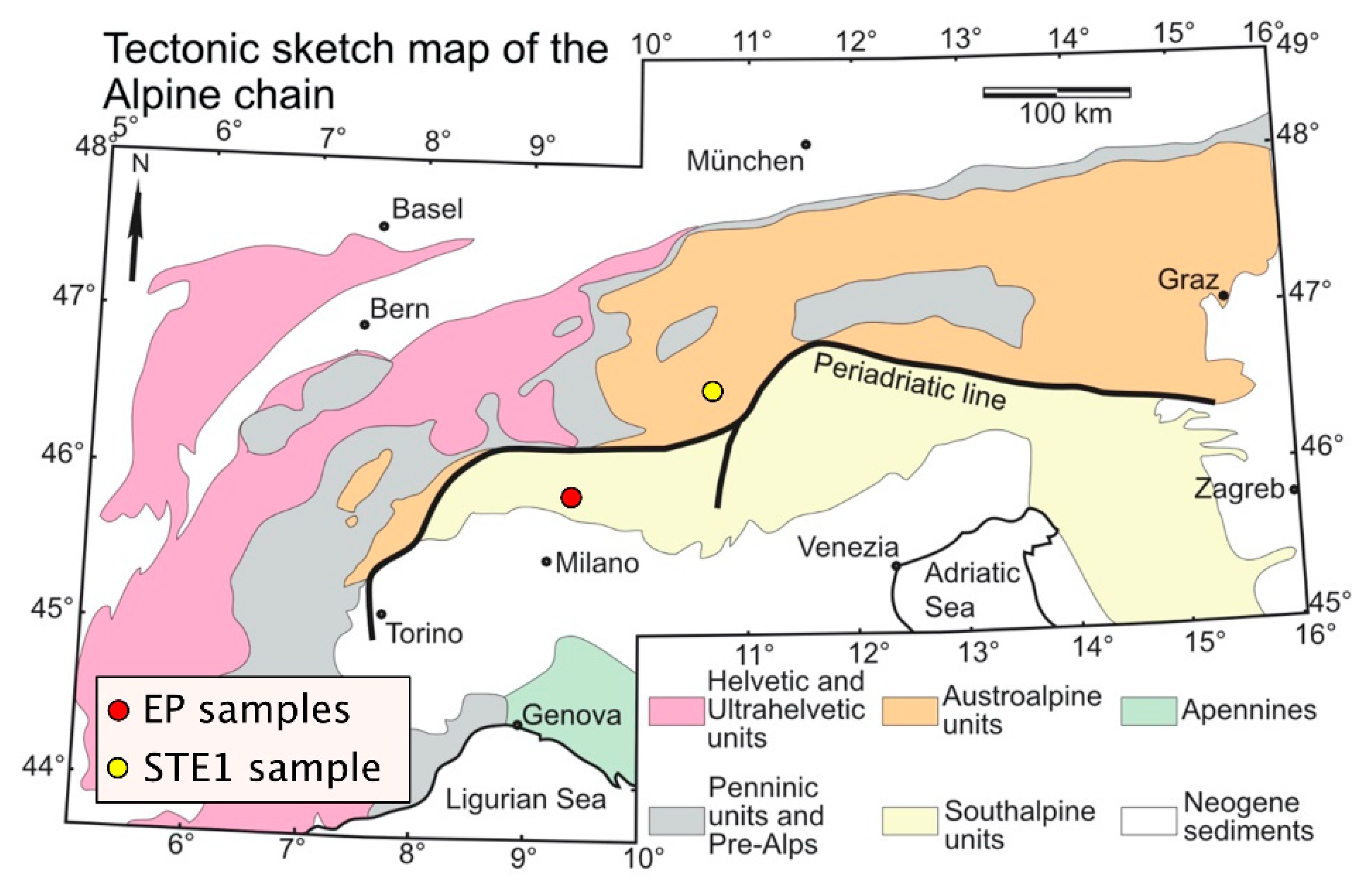
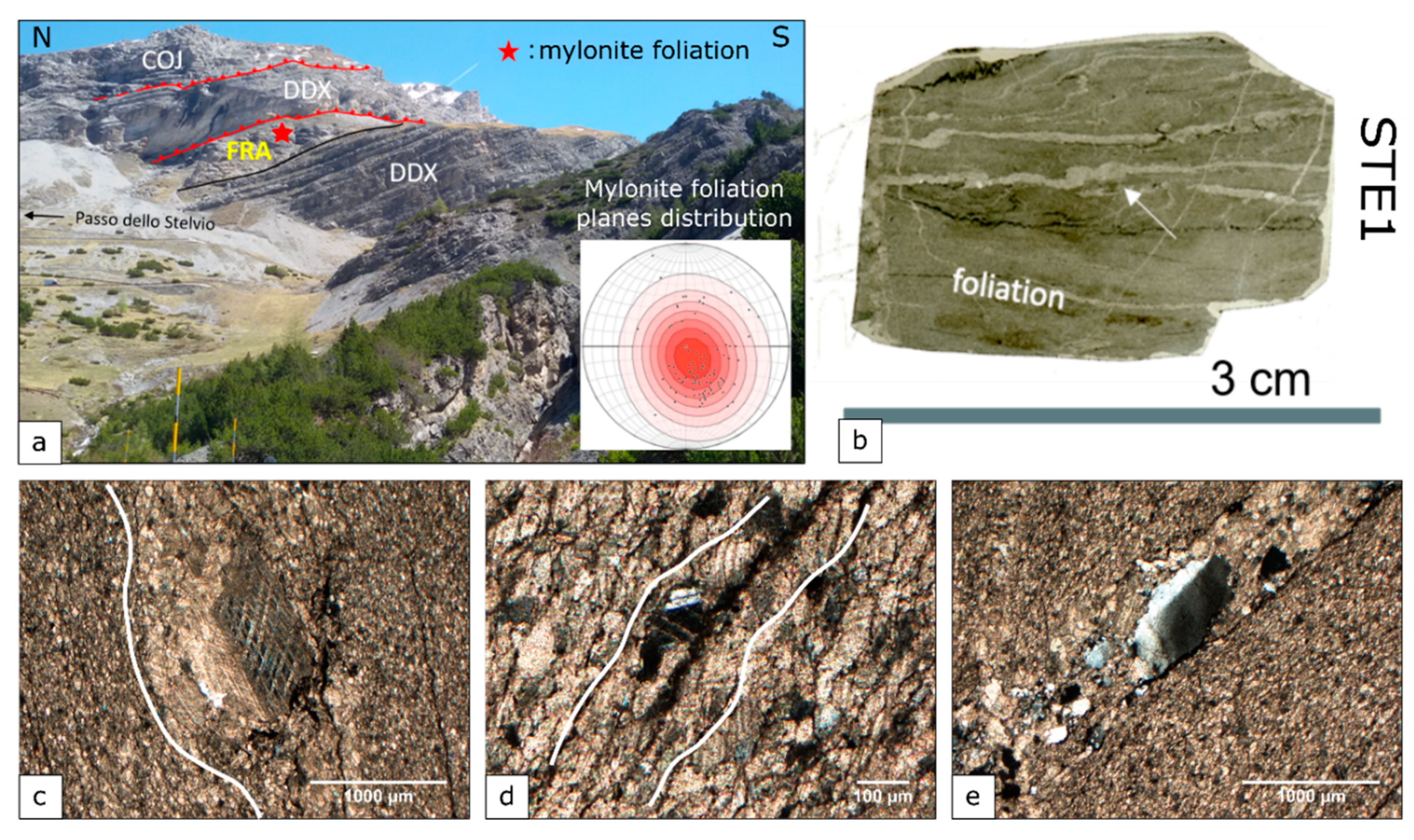
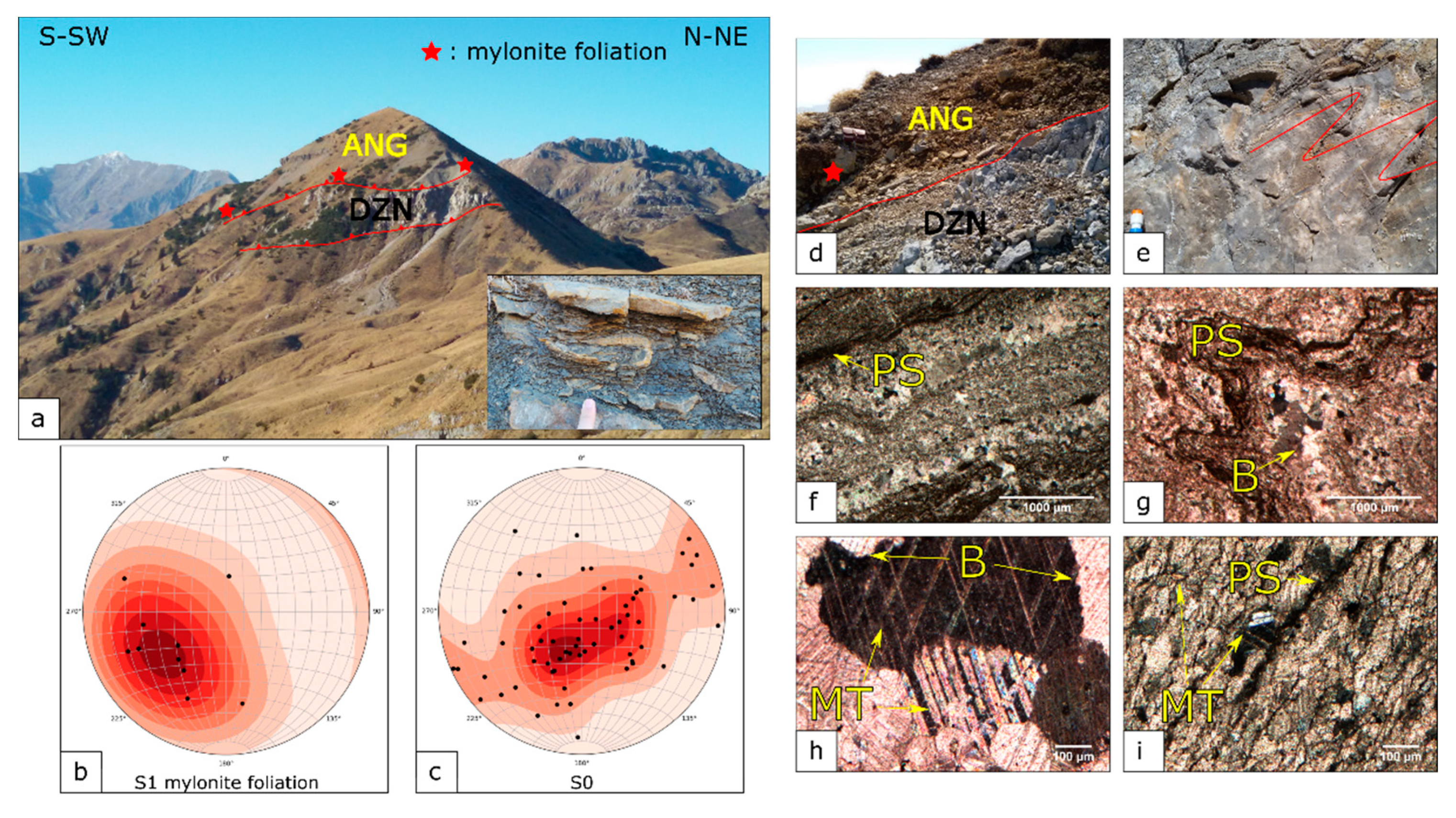
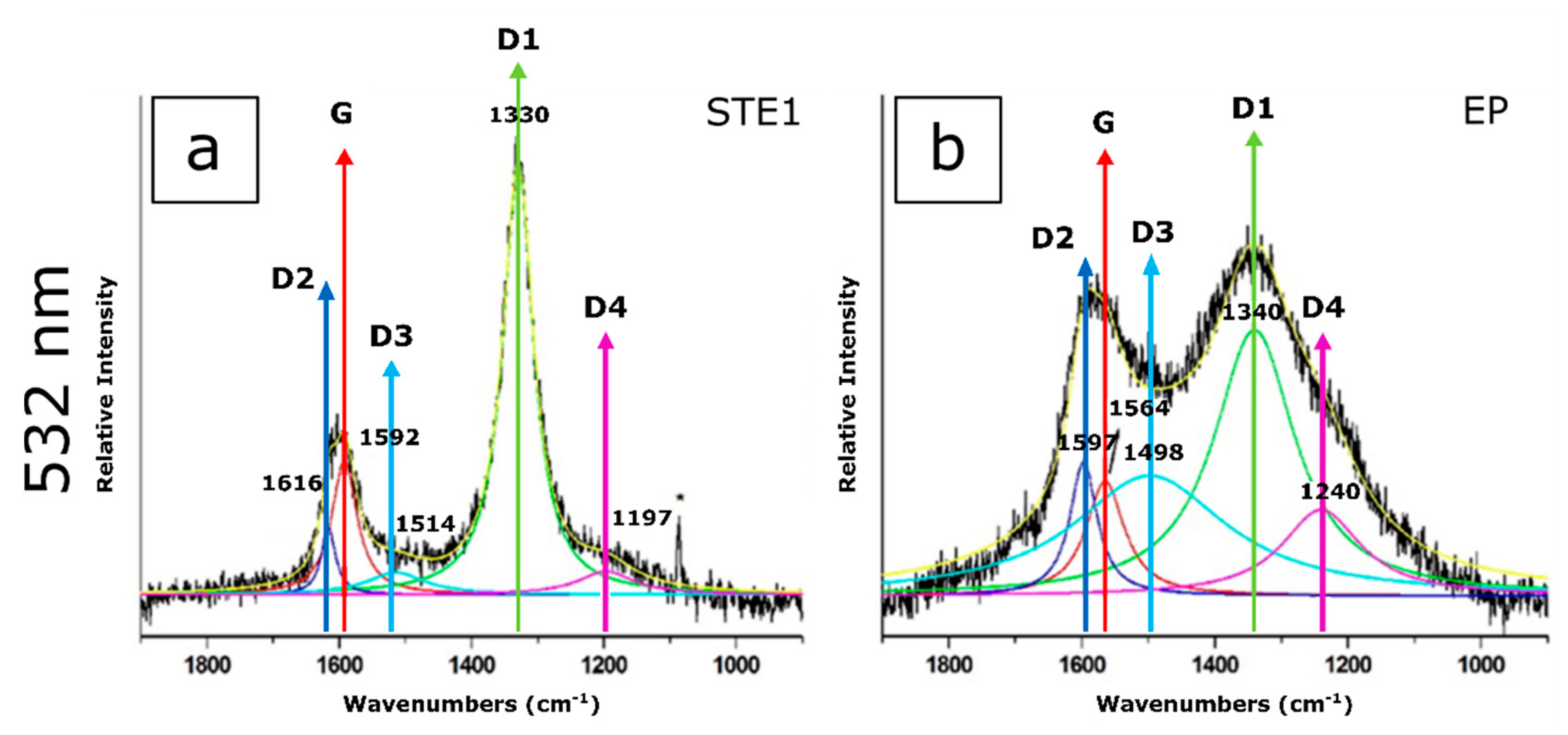
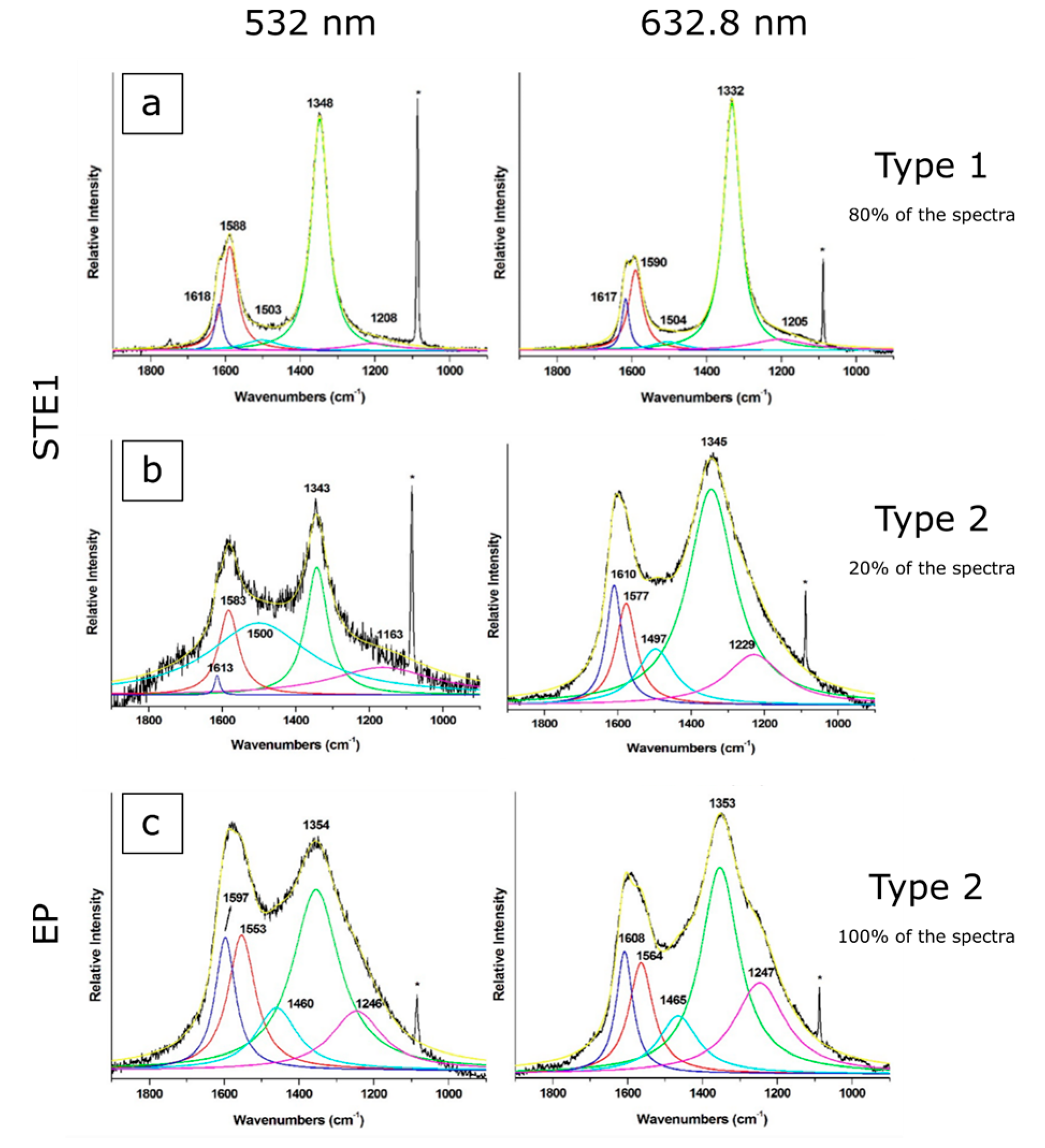
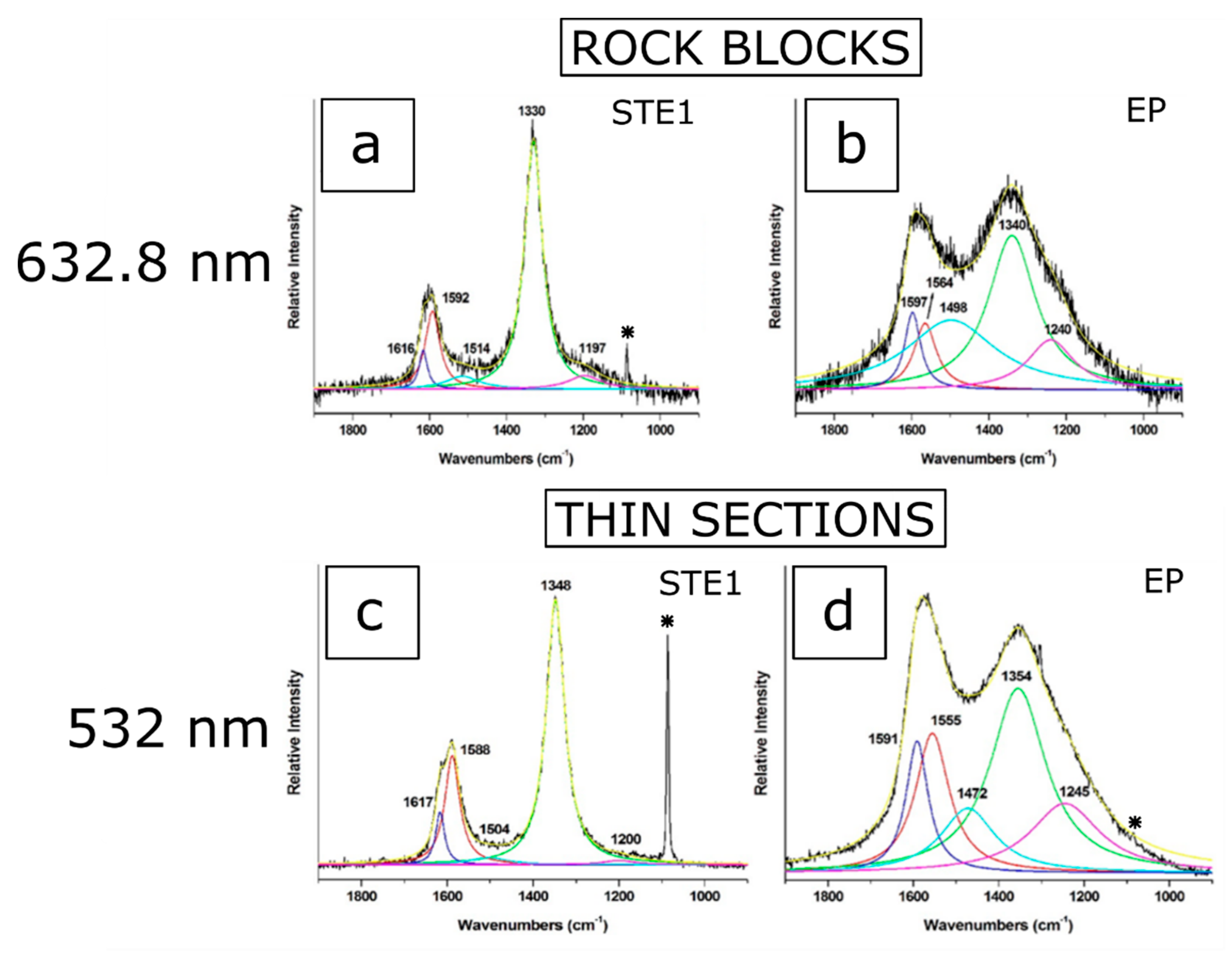
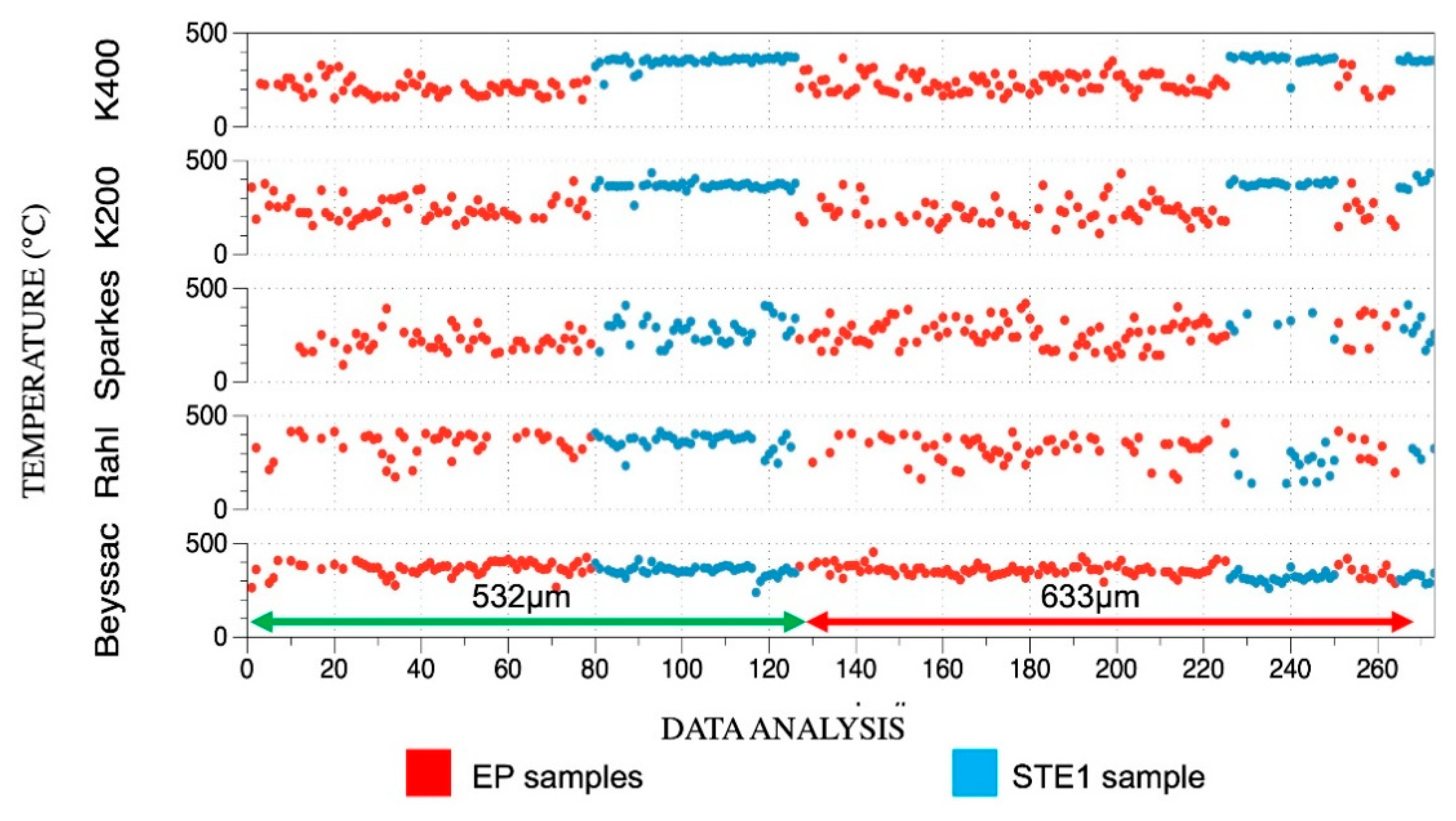
| Sample | Lithology | Formation | Minerals | Deformation Mechanism | Grain Dimension | Mineral Distribution | Estimated Temperatures |
|---|---|---|---|---|---|---|---|
| EP1 | Limestone | Calcare di Angolo (ANG) | Cc, Ox/H-Ox, cl, ±Dol | PS, MT, B, SGR | Min: 0.01 mm Max: 0.79 mm | Ox/H-Ox concentrated in levels; Cc max dimension in fold hinges and single grains within the fine-grained matrix | >200 °C |
| EP4 | Limestone | Calcare di Angolo (ANG) | Cc, Ox/H-Ox, cl, ±Dol | PS, MT, B, SGR | Min: 0.01 mm Max: 0.68 mm | Ox/H-Ox concentrated in levels and dispersed; Cc max dimension concentrated in levels | >200 °C |
| EP7 | Limestone | Calcare di Angolo (ANG) | Cc, Ox/H-Ox, cl, ±Dol | PS, MT, B, SGR | Min: 0.01 mm Max: 1.57 mm | Ox/H-Ox concentrated in levels; Cc max dimension in clusters within the fine-grained matrix | >200 °C |
| STE1 | Limestone | Fraele (FRA) | Cc, Ox/H-Ox, cl, ±Qtz | PS, MT, B, SGR | Min: 0.01 m Max: 1.25 mm | Ox/H-Ox concentrated in levels; Cc max dimension in clusters within the fine-grained matrix and in veins | >200 °C |
| D4 (cm−1) | D1 (cm−1) | D3 (cm−1) | G (cm−1) | D2 (cm−1) | Source (nm) | Sample | Pattern |
|---|---|---|---|---|---|---|---|
| 1208 | 1348 | 1503 | 1588 | 1618 | 532 | STE1 | Type1 |
| 1205 | 1332 | 1504 | 1590 | 1617 | 632.8 | STE1 | Type1 |
| 1163 | 1343 | 1500 | 1583 | 1613 | 532 | STE1 | Type2 |
| 1229 | 1345 | 1497 | 1577 | 1610 | 632.8 | STE1 | Type2 |
| 1246 | 1354 | 1460 | 1563 | 1597 | 532 | EP | Type2 |
| 1247 | 1353 | 1465 | 1564 | 1608 | 632.8 | EP | Type2 |
| Sample | Method | T (°C) Beyssac et al. [1] | T (°C) Rahl et al. [18] | T (°C) Sparkes et al. [10] | T (°C) Kouketsu et al., 2014 [5] | T (°C) Kouketsu et al., 2014 [5] |
|---|---|---|---|---|---|---|
| STE1 | 532 nm block | 375 | 395 | 227 | 339 | 337 |
| 532 nm section | 348 | 302 | 361 | 362 | 367 | |
| 632.8 nm block UPO | 317 | 133 | 463 | 349 | 358 | |
| 633 nm block MI | 316 | 195 | 305 | 354 | 398 | |
| EP1 | 532 nm block | 407 | 408 | 150 | 199 | 217 |
| 532 nm section | 397 | 418 | 176 | 196 | 218 | |
| 632.8 nm block UPO | 391 | 419 | 240 | 239 | 152 | |
| EP4 | 532 nm block | 358 | 329 | 234 | 189 | 257 |
| 632.8 nm block UPO | 359 | 293 | 284 | 218 | 157 | |
| EP7 | 532 nm block | 387 | 421 | 184 | 195 | 174 |
| 532 nm section | 365 | 361 | 252 | 187 | 219 | |
| 632.8 nm block UPO | 376 | 341 | 247 | 239 | 209 | |
| 633 nm block MI | 334 | 295 | 254 | 157 | 150 |
| R1 (D1/G Int) | R2 (D1/(G + D1 + D2) Areas) | RA2 ((D1 + D4)/(G + D2 + D3) Areas) | FWHM-D1 | FWHM-D2 | |
|---|---|---|---|---|---|
| EP 532 nm | 2.32 ± 0.87 | 0.60 ± 0.11 | 1.43 ± 0.48 | 116 ± 24 | 53 ± 17 |
| EP 632.8 nm | 1.58 ± 0.60 | 0.58 ± 0.10 | 1.17 ± 0.38 | 135 ± 24 | 50 ± 15 |
| STE1 532 nm | 3.13 ± 1.25 | 0.65 ± 0.13 | 1.98 ± 0.76 | 67 ± 44 | 27 ± 14 |
| STE1 632.8 nm | 2.04 ± 0.58 | 0.65 ± 0.06 | 1.53 ± 0.41 | 60 ± 15 | 26 ± 10 |
Publisher’s Note: MDPI stays neutral with regard to jurisdictional claims in published maps and institutional affiliations. |
© 2020 by the authors. Licensee MDPI, Basel, Switzerland. This article is an open access article distributed under the terms and conditions of the Creative Commons Attribution (CC BY) license (http://creativecommons.org/licenses/by/4.0/).
Share and Cite
Croce, A.; Pigazzi, E.; Fumagalli, P.; Rinaudo, C.; Zucali, M. Evaluation of Deformation Temperatures in Carbonate Mylonites at Low Temperature Thrust-Tectonic Settings via Micro-Raman Spectroscopy. Minerals 2020, 10, 1068. https://doi.org/10.3390/min10121068
Croce A, Pigazzi E, Fumagalli P, Rinaudo C, Zucali M. Evaluation of Deformation Temperatures in Carbonate Mylonites at Low Temperature Thrust-Tectonic Settings via Micro-Raman Spectroscopy. Minerals. 2020; 10(12):1068. https://doi.org/10.3390/min10121068
Chicago/Turabian StyleCroce, Alessandro, Enrico Pigazzi, Patrizia Fumagalli, Caterina Rinaudo, and Michele Zucali. 2020. "Evaluation of Deformation Temperatures in Carbonate Mylonites at Low Temperature Thrust-Tectonic Settings via Micro-Raman Spectroscopy" Minerals 10, no. 12: 1068. https://doi.org/10.3390/min10121068
APA StyleCroce, A., Pigazzi, E., Fumagalli, P., Rinaudo, C., & Zucali, M. (2020). Evaluation of Deformation Temperatures in Carbonate Mylonites at Low Temperature Thrust-Tectonic Settings via Micro-Raman Spectroscopy. Minerals, 10(12), 1068. https://doi.org/10.3390/min10121068







